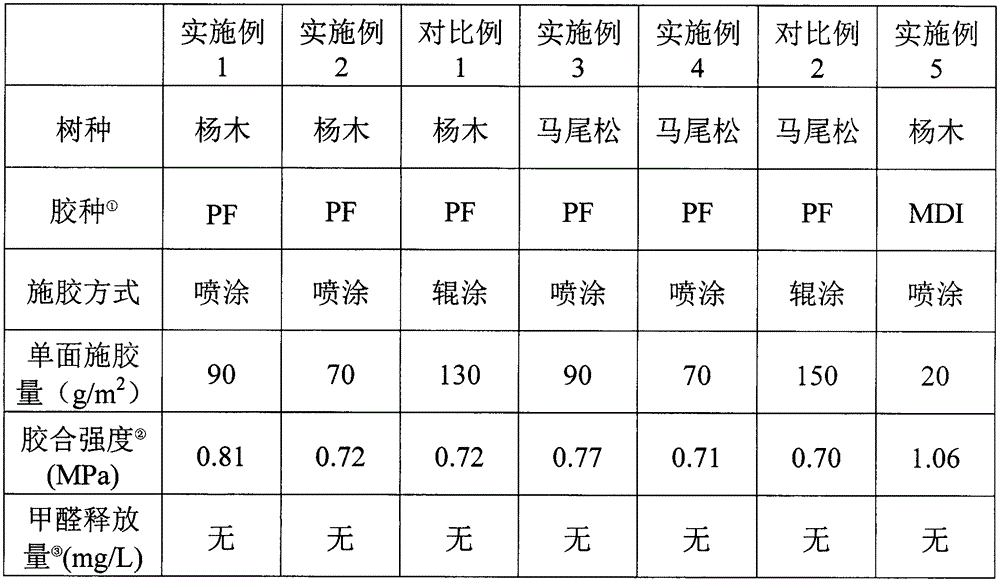Manufacturing method of low-glue-consumption environmental-friendly concrete template
A technology of environmentally friendly concrete and manufacturing method, which is applied in the direction of manufacturing tools, bonding of wooden veneers, other plywood/plywood appliances, etc. The effect of low cost, energy saving and environmental protection in the production process, and short processing time
- Summary
- Abstract
- Description
- Claims
- Application Information
AI Technical Summary
Problems solved by technology
Method used
Image
Examples
Embodiment 1
[0027] The small-diameter fast-growing poplar is cut into a certain length of wood with a circular saw. The length of the wood is determined according to the format requirements of the concrete formwork product, usually the length of the concrete formwork product + 100-150mm. Put the wood section in the cooking tank for softening treatment to increase the plasticity of the wood to improve the quality of the rotary cut veneer. In order to ensure the quality of the concrete formwork, it is necessary to use a special peeling machine to remove the bark of the wood section. Then, a mechanical centering machine is used to determine the center of rotation of the wood section, and then a wood loading machine is used to place the wood section on a rotary cutting machine, and the veneer is cut into a veneer with a thickness of 1.5mm.
[0028] Put the poplar veneer in a hot plate dryer to dry under a certain pressure (less than 0.1MPa). The drying temperature should not be too high and s...
Embodiment 2
[0032] The small-diameter fast-growing poplar is made into a veneer with a thickness of 1.5mm and a moisture content of 6% by the same steps as in Example 1.
[0033] Put the dried veneer on the feeding conveyor belt of the integrated device of low-temperature plasma modification and micro-sizing of wood veneer, enter the low-temperature plasma treatment area driven by the feeding roller, and adjust the upper and lower four pairs of discharge The distance between the electrodes was 7mm. Turn on the low-temperature plasma power supply and adjust the processing power to 4.5KW. When the voltage between the electrodes reaches the air discharge voltage, a dielectric barrier discharge is formed between the electrodes to generate low-temperature plasma. Poplar veneers are suspended in the air at a speed of 10m / min. The four pairs of electrodes pass continuously through the gap, and the low-temperature plasma modification treatment is performed on the upper and lower surfaces of the v...
Embodiment 3
[0038] Masson pine logs were made into veneers with a thickness of 2.5mm and a moisture content of 6% by the same steps as in Example 1.
[0039] Put the dried veneer on the feeding conveyor belt of the integrated device of low-temperature plasma modification and micro-sizing of wood veneer, enter the low-temperature plasma treatment area driven by the feeding roller, and adjust the upper and lower four pairs of discharge The distance between the electrodes was 10 mm. Turn on the low-temperature plasma power supply and adjust the processing power to 4.5KW. When the voltage between the electrodes reaches the air discharge voltage, a dielectric barrier discharge is formed between the electrodes to generate low-temperature plasma. The masson pine veneers are suspended in the air at a speed of 2m / min. The four pairs of electrodes pass continuously through the gap, and the low-temperature plasma modification treatment is performed on the upper and lower surfaces of the veneer at th...
PUM
| Property | Measurement | Unit |
|---|---|---|
| thickness | aaaaa | aaaaa |
| length | aaaaa | aaaaa |
Abstract
Description
Claims
Application Information
 Login to View More
Login to View More - R&D
- Intellectual Property
- Life Sciences
- Materials
- Tech Scout
- Unparalleled Data Quality
- Higher Quality Content
- 60% Fewer Hallucinations
Browse by: Latest US Patents, China's latest patents, Technical Efficacy Thesaurus, Application Domain, Technology Topic, Popular Technical Reports.
© 2025 PatSnap. All rights reserved.Legal|Privacy policy|Modern Slavery Act Transparency Statement|Sitemap|About US| Contact US: help@patsnap.com

